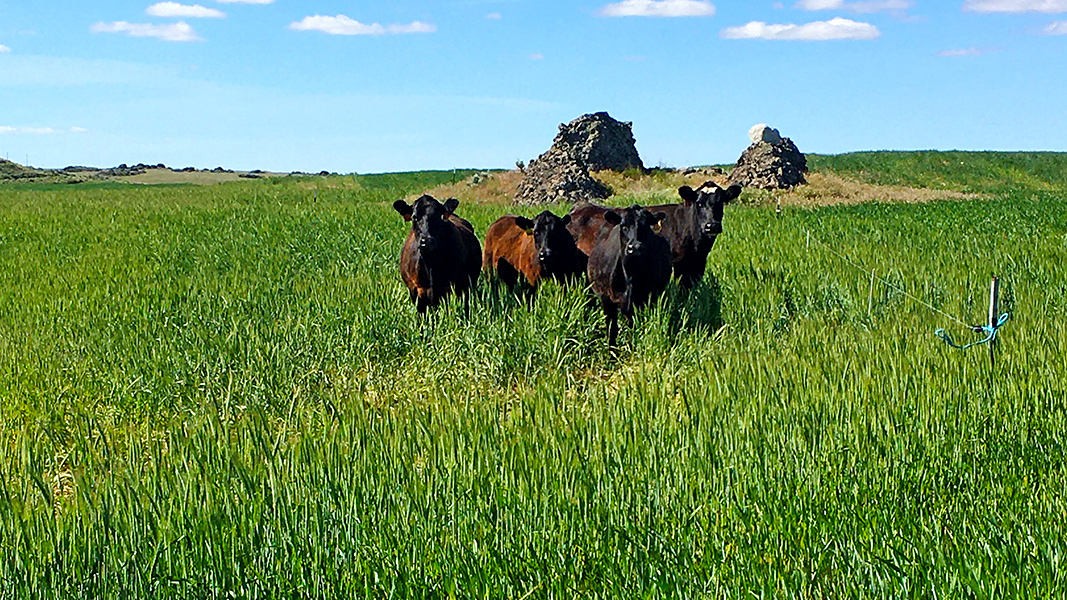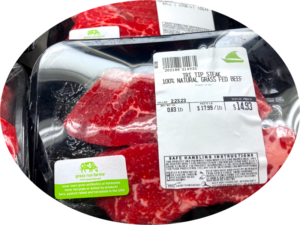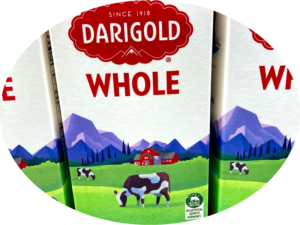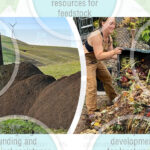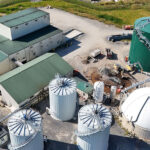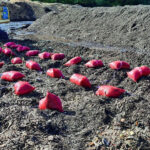Top: Practices with pasture-raised cows may include rotational grazing and feeding on mixed stands of cover crops. Photo by Dierdre Griffin LaHue, Washington State University
 Sally Brown
Sally Brown
Since my beef versus lentil Connections column in the February 8 BioCycle CONNECT, I’ve been reading a lot about “green” cows. Here I don’t mean beef that has gone bad — rather beef from cows raised in more environmentally friendly surroundings. Admittedly, I did not make steak sound all that appetizing in that column. I also painted a picture that was more black and white (or perhaps red (meat) and green (lentils) than the actual reality. Some of what I’ve read suggests that cows are actually good for the planet — in moderation of course. Others point out that eliminating beef from our diets would result in its own set of problems. Details later in the column. Just saying this now to emphasize that eliminating beef and dairy from our diets is not likely to happen overnight.
As with most things, while beef will always be classified as red meat, its environmental impact varies based on multiple factors. The climate impact of eating beef depends on where the particular cow was raised, who his or her parents were, what he or she ate, and if she was also a milk producer. One fact about cows will also always ring true: they fart. From a global perspective, cow farts are the single largest source of methane (CH4) emissions (44% of total CH4) worldwide. In a new book, Our Carbon Hoofprint, I read that cow farts and cow poop are responsible for 30% of the total anthropogenic methane emissions. In addition to their farts, the climate impact of cows extends to the land and fertilizer required to grow their grains and grass.
Cows are ruminants. That means they have multiple stomachs and chew their cud. What is cud you may ask? Cud is the previously chewed and now partially fermented grass that the cows have eaten and eat again. In order to break down hard to digest grasses and cellulose, cows have multiple stomachs. In these stomachs the grass is partially fermented to enable it to break down enough to be digested. In other words, cows make their own sauerkraut, albeit grass based rather than the traditional cabbage version. All that fermentation, digestion and chewing would send me for the Gas X tablets. Unfortunately for cows, there is no ruminant Gas X equivalent. Eating grass makes cows fart and that is a major reason that emissions associated with eating beef are so high. There are plenty of other ruminants. Deer, sheep, giraffes, and antelopes are some examples. Sheep (lamb) is the other that is part of our red meat repertoire. It too has a much higher impact than pork or poultry because of the digestive system of the sheep and their propensity to flatulence.
Cow Fart Reduction
One way to reduce the impact of eating beef is to make the cows fart less. That can be accomplished by changing their diet to include less grass and more easily digestible food. It can also be accomplished by shortening their life span, e.g., reducing the time from calving to killing, effectively reducing the time available for a cow to fart. It may not seem nice for the cows, but feeding them grains for a portion of their lives is one way to effectively do this. Weight gain is faster and more efficient (the ratio of amount eaten to amount gained) and the meat itself is less tough.
Unfortunately for most cows, this diet conversion takes place when they are taken from pasture to a confined feeding operation. Some parts of the world are much more efficient at getting cows fat faster while at the same time making sure that they fart less. For example, the carbon equivalent for a kilogram (kg) of beef in North America is less than 30. In South Asia, that same kg of beef runs you close to 80 kg of carbon dioxide equivalent (CO2e). The farts in the U.S. only make up 10 kg of CO2e per kg of beef. That same cow in Asia lets off about 50 kgs worth of farts for the same steak.
Another is to multitask the animal. If the same cow gives you both meat and milk, the emissions associated with that cow are divided between the two products, effectively reducing the emissions associated with both. In the U.S., we have made major strides in upping milk production per cow through a combination of breeding and improved feeding. That translates into a lower carbon intensity per gallon. Back in 1944, the average dairy cow produced 2,074 kg of milk per year with an estimated carbon intensity of 3.66 kg CO2e/gallon. By 2007, that was up to 9,193 gallons/year with a carbon intensity of 1.35 kg CO2e. Since that time, further improvements have upped production by another 25%.
One way to get both more milk and more meat is hormones. They wreak havoc with us in adolescence and menopause. They make cows gain weight and produce more milk. The goal here is the reverse of any Atkins or Keto or other weight loss program. Giving a cow hormones (recombinant bovine somatotropin or rBST) means that that cow will give you over a gallon more milk per day. In beef production, the combination of breeding, a specially tailored diet, and performance-enhancing technologies (like hormones) means that the cow that gained 0.7 kg/day in 1977 now gains 1.2 kg/day. That translates into a 16% reduction in carbon emissions in getting the steak on your plate.
But Is That Better?
Reading all this may make you feel a little squeamish or like hearing an ad from the Cattle Ranchers Association. Better living through engineered animal production at the expense of what? Many of the practices that are now in favor for cows, e.g., keeping them in pastures eating grass and not giving the dairy cows hormones sound great on paper and in principle, but are they enough to make beef more like lentils in carbon impact if not flavor? If you go to the supermarket, you can find milk that advertises that the cows are rBST free and beef that advertises that the cows were grass fed. In the middle of all of this engineered beef there are some that argue that new grazing systems are the solution. Rather than letting cows sit pretty and overgraze a pasture, cows are shuttled through smaller grazing areas more quickly. Eating fast and furious, the new systems do not degrade pasture vegetation and can result in increases in soil carbon concentrations. Cows are also being integrated into complex rotation systems that also include mixed stands of cover crops. Paige L. Stanley is one of the proponents of these systems. She is a post doc at Colorado State — home to many cows and very few lentils. All of the studies that I’ve looked at of these systems suggest that the soil carbon gains can help to offset the carbon costs of raising beef. Some suggest that they can go so far as to make beef carbon neutral. Even if they can’t do as much as has been claimed, it seems that integrating them into existing practices will provide multiple benefits.
I’ve also read that taking away beef and replacing it with too many fresh vegetables would be bad. High water content in the vegetables and high spoilage rates can up the transport and carbon costs of that type of diet. There are concerns that the land that is used for pasture and to grow crops for cattle feed might meet a less carbon friendly fate if the cows get taken away. To me much of this reflects a fear of life without beef. Reading all of this has also not taken away my need for milk in the morning with my coffee or yogurt for my granola. But long before reading all of this we cut back significantly on our beef consumption.
Reducing Consumption?
In the U.S. we eat a lot of meat. Per capita meat consumption (including all categories) is about 100 kg/year. Other nations (Argentina, Australia and Israel) run a close second (88-90 kg per capita). The world average is 34 kg. Some nations (India, Ethiopia and Nigeria) consume less than 5 kg/person/year. That is what some of us eat over Thanksgiving weekend. In the U.S., the portion of meat that we eat that consists of beef is much lower than it used to be. Reducing the amount of beef and dairy that we consume appears to be happening already. Finding actual milk in the dairy aisle in the supermarket these days requires effort. Soy milk, oat milk, almond milk; all are available at all markets. It is also easy to find hamburgers that have never been anywhere near a ham (or cow for that matter). Accelerating this decline in consumption a little will help a lot. So will improving efficiencies in meat and dairy production across the globe. I don’t think anyone will be coming to take our cows but this is certainly not the time to start eating more meat.
Sally Brown, BioCycle Senior Adviser, is a Research Professor at the University of Washington in the College of the Environment.


